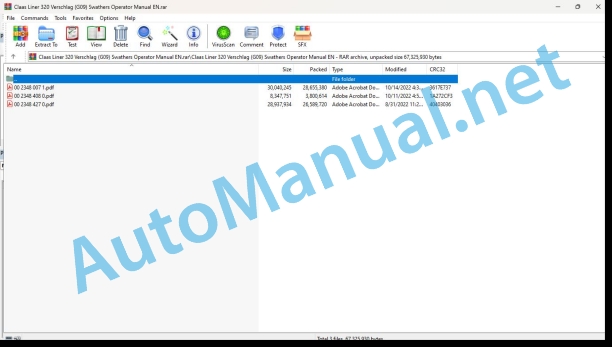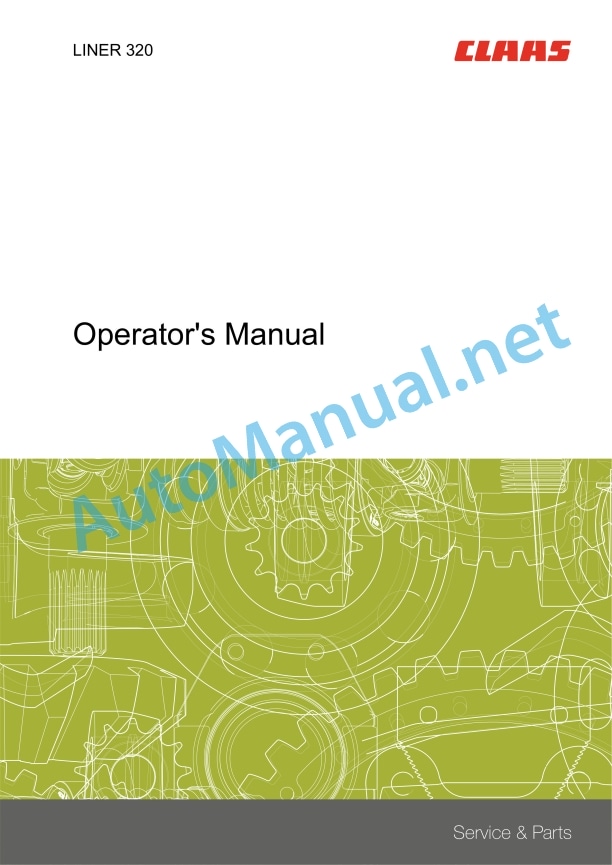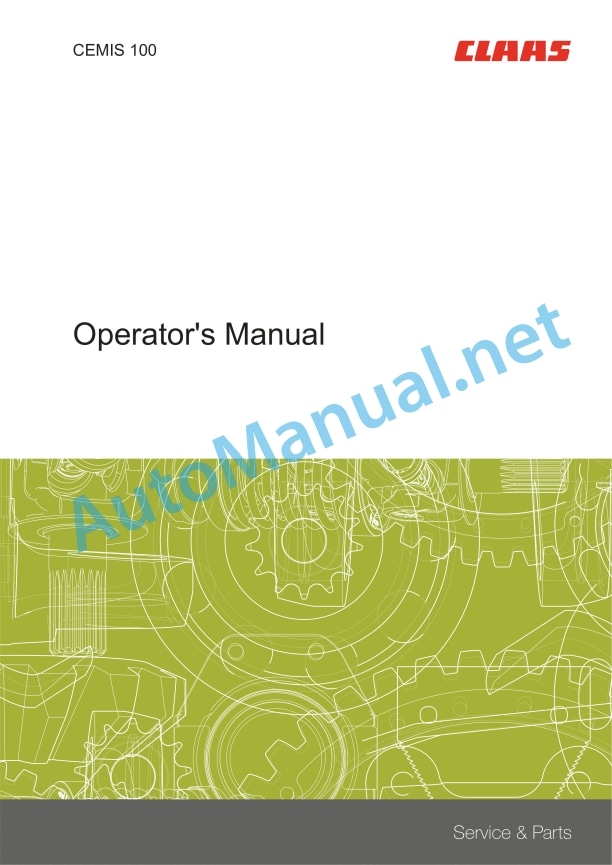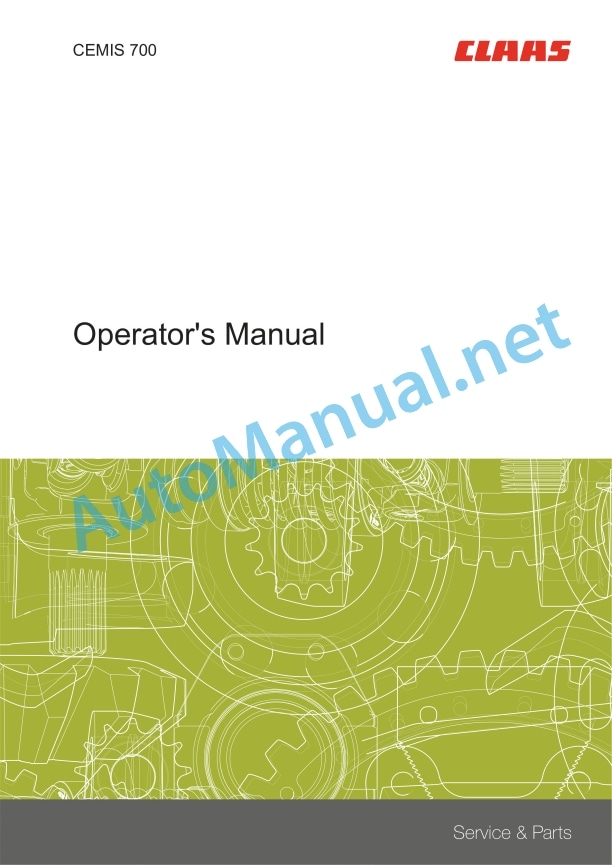Claas Liner 320 Verschlag (G09) Swathers Operator Manual EN
$50.00
- Model: Liner 320 Verschlag (G09) Swathers
- Type Of Manual: Operator Manual
- Language: EN
- Format: PDF(s)
- Size: 56.3 MB
File List:
00 2348 007 1.pdf
00 2348 408 0.pdf
00 2348 427 0.pdf
00 2348 007 1.pdf:
LINER 320
Table of contents
1 Introduction
1.1 Notes on the manual
1.1.1 Validity of the manual
1.1.2 Information about this Operator’s Manual
1.1.3 Symbols and notes
1.1.4 Optional equipment
1.1.5 Qualified specialist workshop
1.1.6 Maintenance notes
1.1.7 Warranty notes
1.1.8 Spare parts and technical questions
1.2 Intended use
1.2.1 Intended use
1.2.2 Reasonably foreseeable misuse
2 Safety
2.1 Identifying warnings
2.1.1 Hazard signs
2.1.2 Signal word
2.2 Safety rules
2.2.1 Importance of Operator’s Manual
2.2.2 Observe the safety decals and warnings
2.2.3 Requirements for all persons working with the machine
2.2.4 Children in danger
2.2.5 Hazard areas
2.2.6 Staying between the tractor and the machine
2.2.7 Persons riding on the machine
2.2.8 Hitching the tractor to the machine
2.2.9 Risk of injury from rotating shafts
2.2.10 Structural changes
2.2.11 Optional equipment and spare parts
2.2.12 Control of the machine while it is running
2.2.13 Only use once properly put into operation
2.2.14 Technical condition
2.2.15 Danger from damage to the machine
2.2.16 Complying with technical limit values
2.2.17 Danger from machine parts running on
2.2.18 Keeping the safety devices functional
2.2.19 Personal protective equipment
2.2.20 Wearing suitable clothing
2.2.21 Removing dirt and loose objects
2.2.22 Preparing the machine for road travel
2.2.23 Risks when driving on the road and in the field
2.2.24 Parking the machine safely
2.2.25 Unsupervised parking
2.2.26 Unsuitable operating utilities
2.2.27 Safe handling of operating and auxiliary utilities
2.2.28 Fire prevention
2.2.29 Environmental protection and disposal
2.2.30 Lethal electrocution from overhead lines
2.2.31 Behaviour in case of voltage flash-over from overhead lines and when lightning strikes
2.2.32 Pressurised fluids
2.2.33 Hot surfaces
2.2.34 Work on the machine only after shutting down
2.2.35 Maintenance work and repairs
2.2.36 Raised machine parts and loads
2.2.37 Danger from welding work
2.3 Safety marking
2.3.1 Layout of safety decals
2.3.2 Safety decals on the machine
3 Machine description
3.1 Overview and method of operation
3.1.1 Machine overview
3.1.2 Function of machine
3.2 Optional equipment
3.2.1 Slip-on yoke, 8-piece*
3.2.2 Warning signs*
3.2.3 Illuminated warning signs*
3.2.4 Warning signs: Italy*
3.2.5 Legal equipment: France*
3.3 Identification plates and identification numbers
3.3.1 Machine identification plate
3.4 Information on the machine
3.4.1 Stickers on the machine
4 Operating and display elements
4.1 Controls
4.1.1 Swathing rotor
4.1.2 Protective frame
5 Technical specifications
5.1 LINER 320
5.1.1 Dimensions
5.1.2 Weights
5.1.3 Requirements for the tractor
5.1.4 Version
5.1.5 Tyre pressure
5.1.6 Noise level
5.1.7 Lubricants
6 Machine preparation
6.1 Adapting the tractor
6.1.1 Checking the ballasting of the tractor
Calculating the minimum front ballast
Calculating the minimum rear ballast
Calculating the actual front axle load
Calculating the actual total weight
Calculating the actual rear axle load
Calculation table
6.1.2 Checking the protective guard on the tractor PTO shaft
6.2 Switching off and securing the machine
6.2.1 Switching off and securing the tractor and machine
6.2.2 Securing the raised machine
6.3 Adapting the machine
6.3.1 Universal drive shaft – checking the length
6.3.2 Adapting the universal drive shaft length
6.3.3 Fitting the universal drive shaft to the machine
6.3.4 Adjusting the inclination of the swathing rotor chassis
6.4 Hitching the machine
6.4.1 Hitching up the headstock
6.4.2 Installing the universal drive shaft
6.4.3 Raising the stand
6.4.4 Connecting the drive lights cable
6.5 Unhitching the machine
6.5.1 Setting the stand down
6.5.2 Disconnecting the drive lights cable
6.5.3 Removing the universal drive shaft
6.5.4 Unhitching the headstock
6.6 Prepare road travel
6.6.1 Pushing the windrowing rubber to the inside
6.6.2 Folding the safety frame up
6.6.3 Removing the tine bars
6.6.4 Performing checks prior to road travel
6.7 Preparing fieldwork
6.7.1 Installing the tine bars
6.7.2 Swinging the safety frame down
6.8 Loading the machine
6.8.1 Lifting the machine
7 Operation
7.1 Driving on the road
7.1.1 Driving on public roads
7.2 Fieldwork settings
7.2.1 Adjusting the swathing rotors
7.2.2 Adjusting the swathing curtain
Adjusting the swath width
7.2.3 Setting the working height
7.3 Fieldwork
7.3.1 Swathing
7.3.2 Adapting the PTO shaft speed
8 Faults and remedies
8.1 Chassis
8.1.1 Changing a wheel on the swathing rotor chassis
8.2 Electric and electronic system
8.2.1 Defective incandescent lamps*
9 Maintenance
9.1 Maintenance interval overview
9.1.1 Before the harvest
9.1.2 After the first 10 operating hours
9.1.3 After the first 50 operating hours
9.1.4 Every 20 operating hours
9.1.5 Every 50 operating hours
9.1.6 Every 500 operating hours or annually
9.1.7 After the harvest
9.2 Gearbox
9.2.1 Checking the gearbox for leaks
9.2.2 Check the oil level in the swath gearbox
9.2.3 Changing the oil in the swath gearbox
9.3 Clutch
9.3.1 Checking the overload clutch
9.4 Universal drive shaft
9.4.1 Servicing the universal drive shafts
9.5 Chassis
9.5.1 Check the tyre pressure
9.5.2 Check the wheel nuts on the swathing rotor chassis
9.6 Rotor
9.6.1 Check the bolts of the swathing gearbox
9.6.2 Checking the tines
9.7 Assembly parts and machine body
9.7.1 Clean the machine
9.7.2 Preserve the machine
9.7.3 Check the fittings
9.8 Lubrication plan
9.8.1 Lubrication points every 20 operating hours
9.8.2 Lubrication points every 50 operating hours
10 Putting out of operation and disposal
10.1 General information
10.1.1 Putting out of operation and disposal
11 EC declaration of conformity
11.1 LINER 320
11.1.1 EC Declaration of Conformity
12 Technical terms and abbreviations
12.1 Terms and explanations
12.1.1 Technical terms
12.1.2 Abbreviations
00 2348 408 0.pdf:
CEMIS 100
Table of contents
1 Introduction
1.1 General information
1.1.1 Validity of the manual
1.1.2 Information about this Operator’s Manual
1.1.3 Symbols and notes
1.2 Intended use
1.2.1 Intended use
1.2.2 Reasonably foreseeable misuse
2 Safety
2.1 Safety rules
2.1.1 General safety and accident prevention regulations
2.1.2 Interaction between terminal and machine or tractor
2.1.3 Electrocution by electrical system
3 Product description
3.1 Overview and method of operation
3.1.1 Overview of CEMIS 100
3.1.2 Function principle of CEMIS 100
3.2 Identification plates and identification numbers
3.2.1 Spare parts and technical questions
3.2.2 Identification plate of CEMIS 100
4 Operating and display elements
4.1 CEMIS 100
4.1.1 User interface for LINER
4.1.2 User interface for ROLLANT
4.1.3 User interface for UNIWRAP
5 Technical specifications
5.1 CEMIS 100
5.1.1 Specification
6 Operation
6.1 CEMIS 100
6.1.1 Operating the CEMIS 100
6.1.2 Switching CEMIS 100 on
6.1.3 Switching CEMIS 100 off
7 Maintenance
7.1 CEMIS 100
7.1.1 Daily
8 Putting out of operation and disposal
8.1 General information
8.1.1 Removal from service and disposal
9 Technical terms and abbreviations
9.1 Terms and explanations
9.1.1 Technical words
9.1.2 Abbreviations
00 2348 427 0.pdf:
CEMIS 700
Table of contents
1 Introduction
1.1 General information
1.1.1 Validity of the manual
1.1.2 Information about this Operator’s Manual
1.1.3 Symbols and notes
1.2 Intended use
1.2.1 Intended use
1.2.2 Reasonably foreseeable misuse
2 Safety
2.1 Safety rules
2.1.1 General safety and accident prevention regulations
2.1.2 Interaction between terminal and machine or tractor
2.1.3 Electrocution by electrical system
3 Product description
3.1 Overview and method of operation
3.1.1 Overview of CEMIS 700
3.1.2 Function principle of CEMIS 700
3.2 Identification plates and identification numbers
3.2.1 Spare parts and technical questions
3.2.2 Identification plate of CEMIS 700
4 Information on the product
4.1 Software version
5 Operating and display elements
5.1 CEMIS 700
5.1.1 User interface
5.1.2 Terminal program
6 Technical specifications
6.1 CEMIS 700
6.1.1 Specification
7 Operation
7.1 CEMIS 700
7.1.1 Operating the CEMIS 700
7.1.2 Switching CEMIS 700 on
7.1.3 Switching CEMIS 700 off
7.2 Terminal settings
7.2.1 Making settings
Making settings with the rotary button
Making settings with the touch function
7.2.2 Setting the screen lighting
Daytime mode
Nighttime mode
Activating automatic key lighting
7.2.3 Setting the time and date
7.2.4 Displaying diagnosis information
On-board power supply voltage display
Display of CLAAS ISOBUS ECU address and name
7.2.5 Setting the language and display formats
Setting the language
Setting display formats
7.2.6 Setting the volume
7.2.7 Deleting an ISOBUS implement
8 Maintenance
8.1 Maintenance
8.1.1 Daily
9 Putting out of operation and disposal
9.1 General information
9.1.1 Removal from service and disposal
10 Technical terms and abbreviations
10.1 Terms and explanations
10.1.1 Technical words
10.1.2 Abbreviations
John Deere Repair Technical Manual PDF
John Deere Repair Technical Manual PDF
John Deere Repair Technical Manual PDF
John Deere Repair Technical Manual PDF
John Deere Repair Technical Manual PDF
John Deere 16, 18, 20 and 24HP Onan Engines Component Technical Manual CTM2 (19APR90)
New Holland Service Manual PDF
John Deere Repair Technical Manual PDF
John Deere Repair Technical Manual PDF
John Deere 18-Speed PST Repair Manual Component Technical Manual CTM168 10DEC07
John Deere Repair Technical Manual PDF
John Deere Diesel Engines PowerTech 4.5L and 6.8L – Motor Base Technical Manual 07MAY08 Portuguese
John Deere Repair Technical Manual PDF























